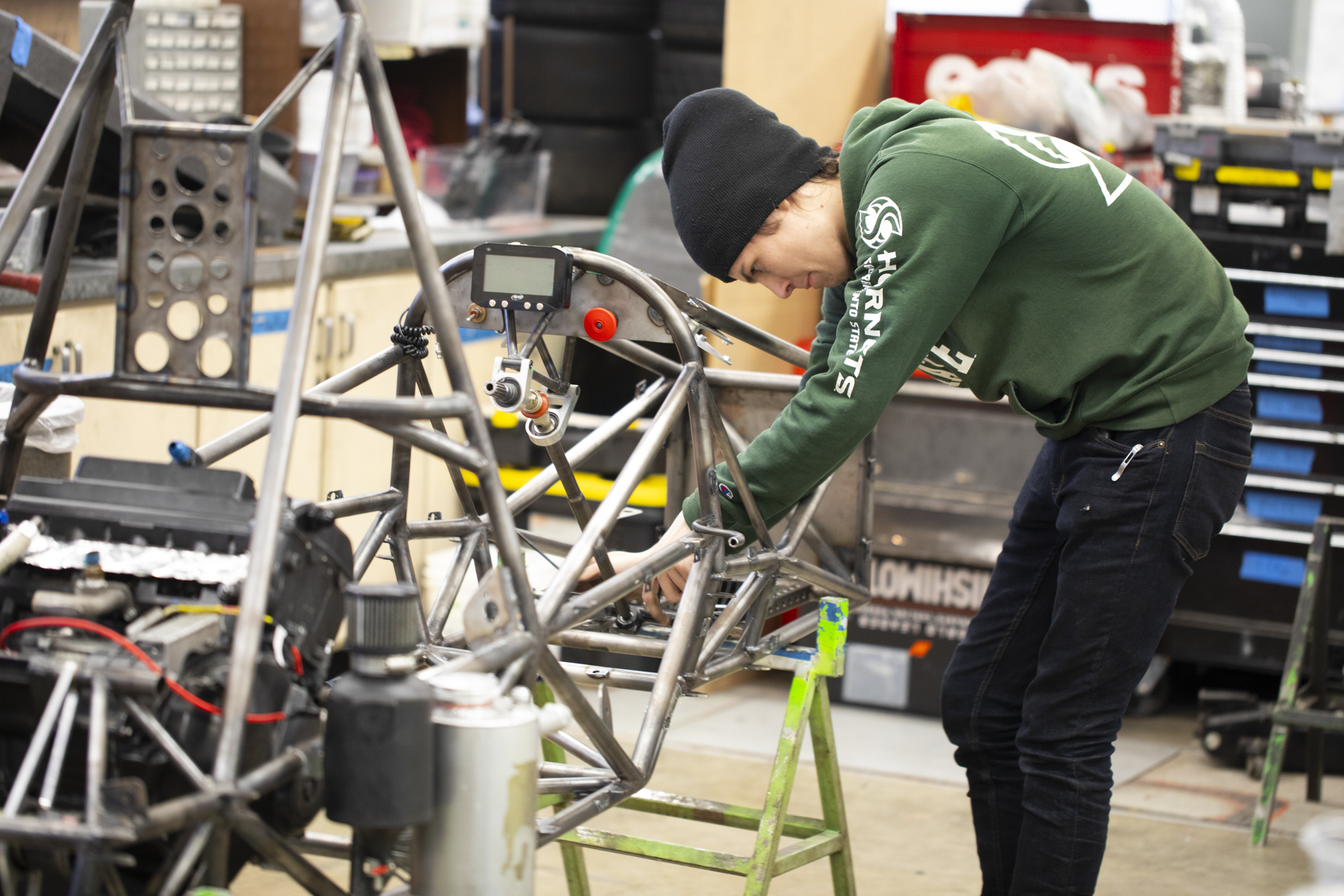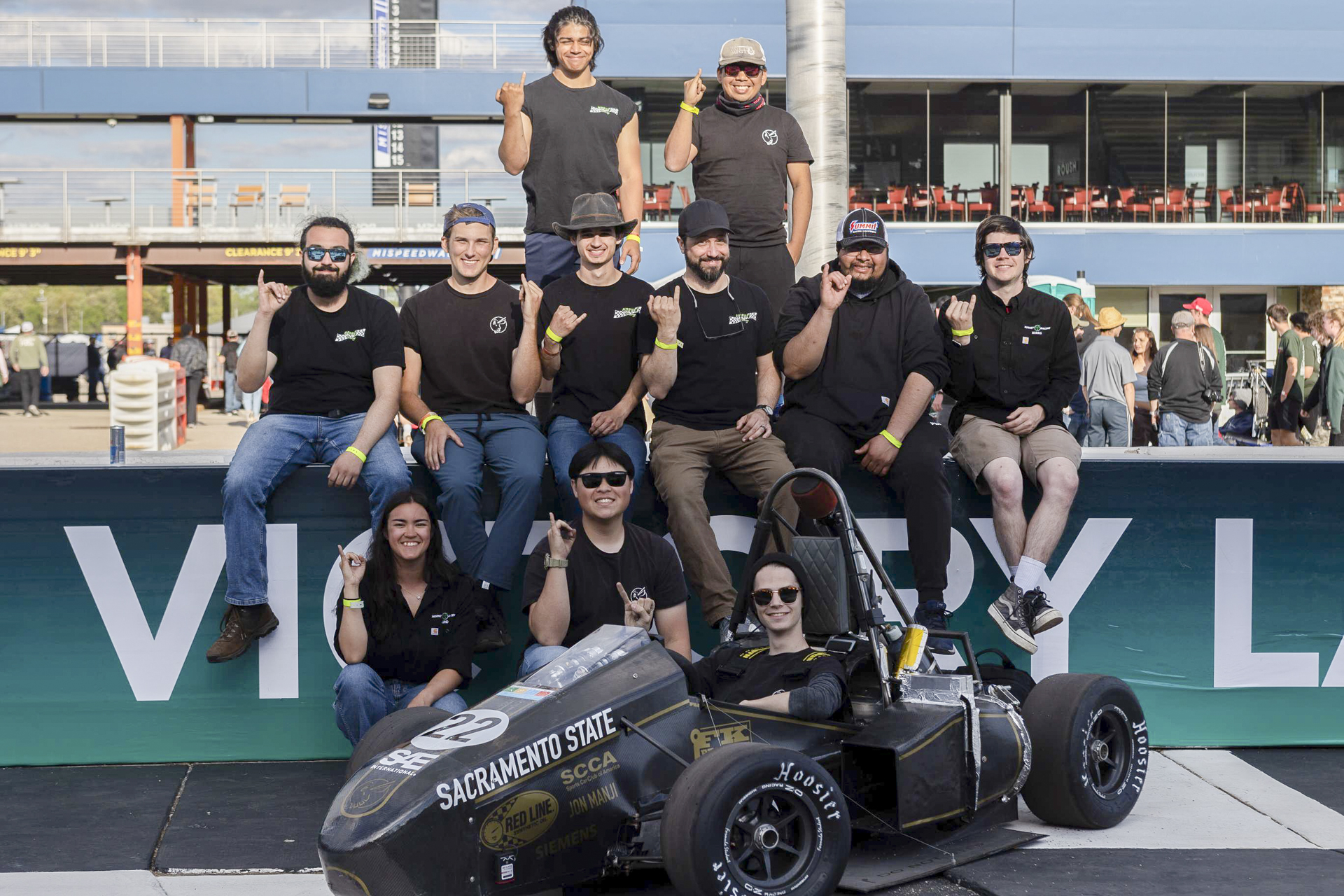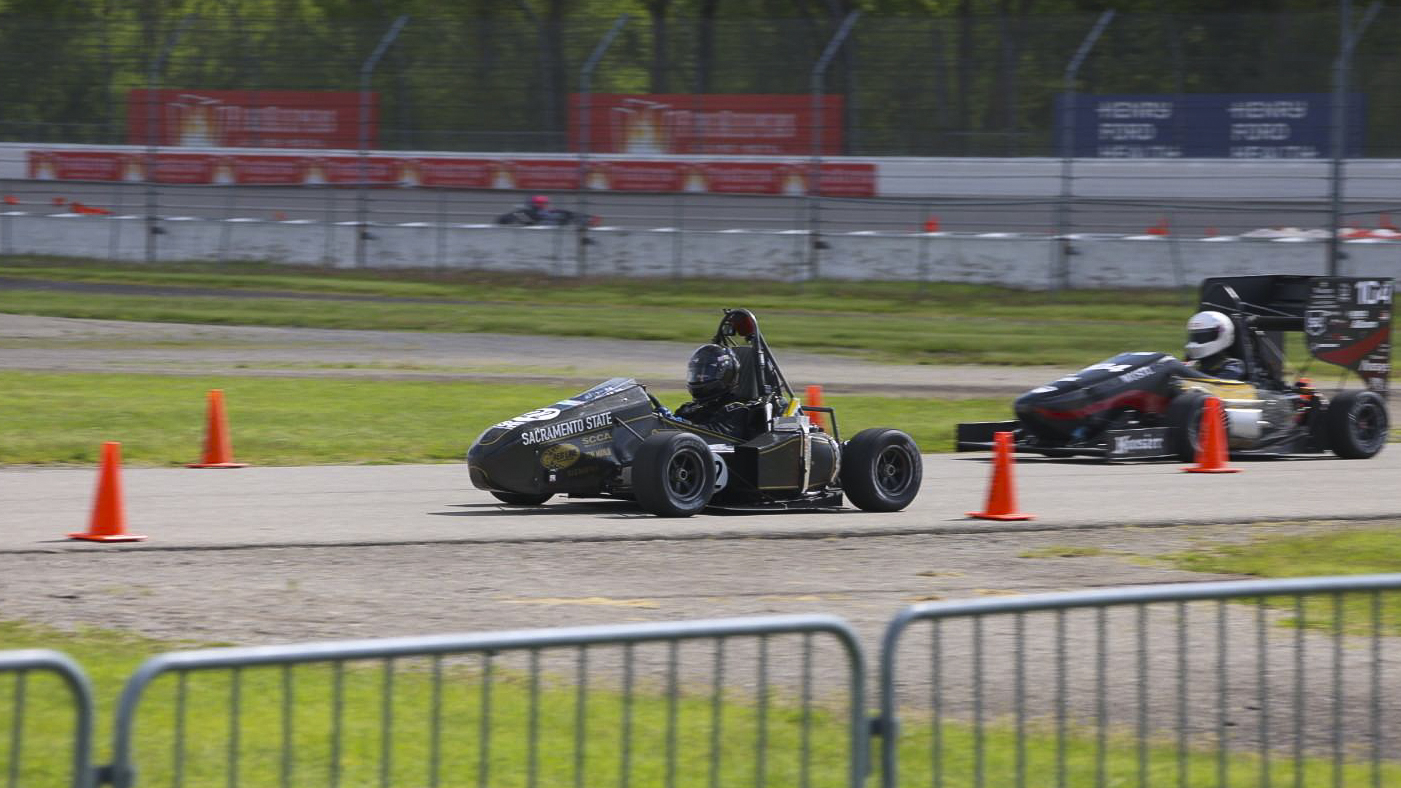Story Content
Hornet Racing’s teamwork results in significant improvement at international competition

June 05, 2024
With grease under their fingernails and determination on their faces, some Sacramento State students spend hundreds of hours each year in a space more like a garage than a classroom, as they design, build, test and tweak the University’s Formula 1-style race car, preparing it for annual competition.
The most recent test for Hornet Racing, a student-run club in the College of Engineering and Computer Science (ECS), was a competition May 8-11 against more than 100 colleges and universities from around the world at Formula SAE Michigan.
Hornet Racing (HR) placed 40th out of 108 teams at the competition, a dramatic advance of 51 spots over its 2023 finish and sixth among 10 California teams. The annual event was held at Michigan International Speedway in Brooklyn, Michigan.
“I'm super proud of the team,” said club president Jason Tran, a Mechanical Engineering major on track to graduate next spring. “We came back strong, and we finished all of our events.”
Competition organizer SAE International says, “Formula SAE competitions challenge teams of university undergraduate and graduate students to conceive, design, fabricate, develop and compete with small, formula-style vehicles.” Teams must qualify for each event, which include, among others, acceleration, autocross and an endurance race. Sac State placed 30th out of 49 teams in the latter.
Tran, who joined HR in 2020, said the team’s performance marked a return to form following setbacks during the COVID-19 pandemic.
“We had two or three members in 2020, and they really kept the club alive,” said Tran, one of 20 active members. “There was definitely no competition, in-person at least. It was weird to be on Zoom and (explaining) our designs to the judges.”

Hornet Racing started in 1995 and is open to all students. Most members are engineering majors, but Nico Pfeifer, HR vice president, said opportunities on the full-fledged collegiate racing team exist for students interested in finance, business and marketing.
“Almost everyone that joins this club is interested in cars,” said Pfeifer, a second-year Electrical Engineering major. “Even if they’re not, they’re almost always willing to learn.”
The program and some expenses are primarily funded by the college, but the team also raises money through events, donations and support from sponsors, including Underground Construction, Jon Manji, SAE and others. In racing tradition, sponsors are proudly displayed on the body of the car, dubbed HR22.
“HR and other ECS clubs are a great opportunity for students who may not know much about some of these fields to learn more and get more involved,” ECS Dean Kevan Shafizadeh said. “They extend classroom learning by providing hands-on experiences, fostering creativity and enhancing critical thinking skills.”
Cars are required to pass myriad inspections and safety checks before teams compete. HR22, which rides about 3 inches from the ground and maxes out at about 65 mph, includes two engine kill switches and a safety harness, and drivers must be physically able to exit their car within five seconds in case of an emergency.
Faculty advisor Christopher Savarino, a Sac State alum who teaches Mechanical Engineering, said completing the steps to compete is a significant achievement. These include developing financing – the $2,750 entry fee, travel and accommodations costs – and passing the competition’s tests.
“A lot of teams don't get past the first couple of stages,” Savarino said. “So, even just being able to get through and do them all and do (the endurance race) is a big accomplishment.”
The team uses computer software to design the car during the fall semester before sending the design to a Canadian company, which fabricates the frame. Welding and vehicle assembly occur in the spring, utilizing carbon fiber body materials donated by Mitsubishi. Mechanical parts, such as a Honda motorcycle engine, are reused with each iteration of the car, valued at $18,077 this year. New parts are sourced when necessary.
The goal of the car’s design is to improve competition event times. HR22 weighs about 465 pounds, about 24 pounds lighter than last year’s vehicle – a significant improvement.
“Every pound is basically a second taken off your car when driving endurance,” Tran said.
Drivers are required to know a little bit about everything so they can provide feedback to the team, said third-year Mechanical Engineering major Matthew Pena, one of four drivers.
“Driving it is very fun, but it’s also very difficult,” said Pena, a racing hobbyist who plans to study medicine. “There's a lot of intuition that goes into it, and a lot of practice and muscle memory.”
Each team is required to have at least three drivers, Pfeifer said, so drivers can take turns. It ensures fairness and avoids driver burnout.
“It’s just about safety,” said the team’s tech director, Skyler Lund, a third-year Mechanical Engineering major. “Three of the events happen in one day, so you don’t want drivers getting too tired and driving off the track.”
Savarino said he is proud of the team.
“It’s just kind of awe-inspiring with how much dedication and time and effort is put into it,” said Savarino, who has advised the team for two semesters and whose son recently joined the team. “They’re learning so much, getting so many hands-on skills and just real-world problem solving.”
Savarino said other benefits for students include networking and connecting with program alumni, who often help HR team members land jobs, learning desirable job skills, and the camaraderie and experience of working as a team.
Former HR member and 2020 Mechanical Engineering graduate Grayson Browne, who works for professional racing company Pratt Miller, can attest to the benefits.
“It provided a great opportunity to get some hands-on experience and practical knowledge,” Browne said. “I would not have gotten a job in motorsports without the time I had spent with the team.”
For students who may want to get involved, Tran offered some advice.
“Don’t worry about your skill level, just come and participate,” he said. “Everyone starts somewhere. Just come and be prepared to participate and try to learn.”

Media Resources
Faculty/Staff Resources
Looking for a Faculty Expert?
Contact University Communications
(916) 217-8366
communications@csus.edu


